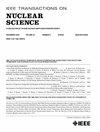Design, Modeling, and Characterization of a Floating Gate Dosimeter in Standard CMOS Technology for Sensor Reuse
IF 1.9
3区 工程技术
Q3 ENGINEERING, ELECTRICAL & ELECTRONIC
引用次数: 0
Abstract
This article presents the design, model, and characterization of a floating gate dosimeter (FGDOS), fabricated using standard complementary metal-oxide-semiconductor (CMOS) technology. The proposed model incorporates a parameter to account for trapped charge on the oxide, thereby providing deeper physical insight into the device’s behavior. We present a comprehensive comparison between the proposed model and experimental data, validating the accuracy of the proposed model. In addition, we propose a characterization method to extract key parameters of the FGDOS. Experimental validation was conducted using a 6 MeV linear accelerator and an X-ray diffractometer, with results demonstrating the model’s accuracy across a dose range of over 100 Gy (H2O). Finally, we show that, after each reset of the floating gate (FG), the dose can be determined from a normalized sensitivity, which is independent of the previous history of the sensor. This means that the FGDOS can be reused several times and still keep the same dependence of the normalized sensitivity on the dose.用于传感器重用的标准CMOS技术浮门剂量计的设计、建模和表征
本文介绍了采用标准互补金属氧化物半导体(CMOS)技术制造的浮栅剂量计(FGDOS)的设计、模型和特性。所提出的模型包含了一个参数来解释氧化物上捕获的电荷,从而为器件的行为提供了更深入的物理见解。我们将所提出的模型与实验数据进行了全面的比较,验证了所提出模型的准确性。此外,我们还提出了一种提取FGDOS关键参数的表征方法。使用6 MeV直线加速器和x射线衍射仪进行了实验验证,结果表明该模型在超过100 Gy (H2O)剂量范围内的准确性。最后,我们表明,每次浮门(FG)复位后,剂量可以由归一化灵敏度确定,该灵敏度与传感器以前的历史无关。这意味着fgdo可以重复使用几次,并且仍然保持对剂量的归一化灵敏度的相同依赖性。
本文章由计算机程序翻译,如有差异,请以英文原文为准。
求助全文
约1分钟内获得全文
求助全文
来源期刊

IEEE Transactions on Nuclear Science
工程技术-工程:电子与电气
CiteScore
3.70
自引率
27.80%
发文量
314
审稿时长
6.2 months
期刊介绍:
The IEEE Transactions on Nuclear Science is a publication of the IEEE Nuclear and Plasma Sciences Society. It is viewed as the primary source of technical information in many of the areas it covers. As judged by JCR impact factor, TNS consistently ranks in the top five journals in the category of Nuclear Science & Technology. It has one of the higher immediacy indices, indicating that the information it publishes is viewed as timely, and has a relatively long citation half-life, indicating that the published information also is viewed as valuable for a number of years.
The IEEE Transactions on Nuclear Science is published bimonthly. Its scope includes all aspects of the theory and application of nuclear science and engineering. It focuses on instrumentation for the detection and measurement of ionizing radiation; particle accelerators and their controls; nuclear medicine and its application; effects of radiation on materials, components, and systems; reactor instrumentation and controls; and measurement of radiation in space.
 求助内容:
求助内容: 应助结果提醒方式:
应助结果提醒方式:


